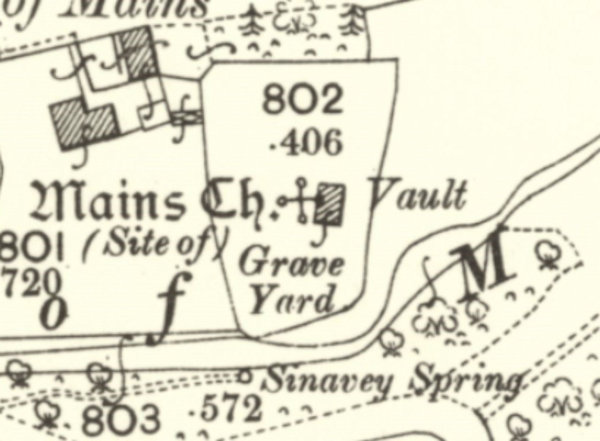 |
Dedication: Saint Ninian? Location: Mill o' Mains, Dundee Coordinates: 56.48566, -2.95834 Grid reference: NO410330 Status: unknown Heritage designation: none |
 |
Dedication: Saint Ninian? Location: Mill o' Mains, Dundee Coordinates: 56.48566, -2.95834 Grid reference: NO410330 Status: unknown Heritage designation: none |
Sinivee Well, also called "Sinavey Well", is (or was) a rather mysterious spring. It is thought that the name "Sinivee" must be a corruption of something else, although what exactly the name is a corruption of has been debated over the centuries. Apart from its odd name, almost nothing is known of its history, although its proximity to the nearby site of St Ninian's Church makes it likely that the well's water was used for baptisms, regardless of its dedication, and it was probably used as drinking water for the nearby castle, as it was supposedly "renowned for its excellent quality" (according to the Canmore database).
It has been suggested that the well may have once been dedicated to St Ive. "Sinivee" could quite plausibly be a derivative of "St Ivee"; likewise, so could "Sinavey". Andrew Jervis expressed this opinion in a footnote in Memorials of Angus and the Mearns, in 1861. It is, however, doubtful that this well was ever dedicated to St Ive, as the saint is not known to have travelled any further than Cornwall during her lifetime, and, from all evidence, it seems that any veneration of her was strictly confined to that area of England. There are no churches or monuments (or holy wells) that bear St Ive's name anywhere in Scotland, or even in the north of England, so it would be a very unusual phenomenon indeed.
A second theory contains no mention of saints at all, and instead is more of a local tradition, which is that the name "Sinivee" is a corruption of "Sunny Vie". Jervis also documents this theory in the very same book:
|
A romantic den separates the castle from the old kirkyard of the parish, in which is the burial vault of the Grahams - a small unadorned grey building. In the den, near the churchyard, a spring is known by the name of Sinivee - probably a corruption of that of some old saint, although it is locally said to have been so called because the sun rarely shines upon it! |
A final theory, and the one that seems to have gained the most traction, is that the well's name is a corruption of "St Ninian". This idea is documented on the Canmore database, and is made all the more likely by the fact that the well is (or was) located so near to the site of St Ninian's Church. Indeed, the spring is (or was) located right next to the site of the chapel. It is, therefore, most likely that the well was originally dedicated to St Ninian, who was a relatively local saint, and who is supposed to have journeyed through this exact area on a mission to convert the Picts.
Today, the condition of the well is uncertain. It is no longer marked on Ordnance Survey maps, as it once was, although this does not necessarily mean that it does not exist.
|
Access: The well (if it still exists) is located at the bottom of what looks like a rather steep wooded bank, next to a small river; as such, the site may be flooded in bad weather. |
Images:
Old OS maps are reproduced with the permission of the National Library of Scotland
Copyright 2025 britishholywells.co.uk